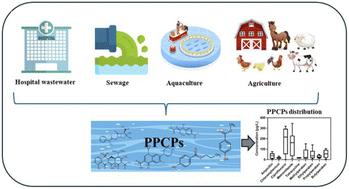当前位置:
X-MOL 学术
›
Environ. Sci.: Processes Impacts
›
论文详情
Our official English website, www.x-mol.net, welcomes your
feedback! (Note: you will need to create a separate account there.)
Occurrence profiling, risk assessment, and correlations of antimicrobials in surface water and groundwater systems in Southwest Nigeria
Environmental Science: Processes & Impacts ( IF 4.3 ) Pub Date : 2024-01-23 , DOI: 10.1039/d3em00516j Nathaniel B Bolujoko 1, 2 , Damilare Olorunnisola 1, 2, 3, 4 , Sonika Poudel 5 , Martins O Omorogie 1, 2 , Olumuyiwa O Ogunlaja 1, 6 , Chidinma G Olorunnisola 1, 4 , Morenike Adesina 1, 4 , Esther Deguenon 7 , Victorien Dougnon 7 , Moses O Alfred 1, 2 , Aemere Ogunlaja 1, 8 , Olumide D Olukanni 1, 9 , Titus A M Msagati 10 , Emmanuel I Unuabonah 1, 2
Environmental Science: Processes & Impacts ( IF 4.3 ) Pub Date : 2024-01-23 , DOI: 10.1039/d3em00516j Nathaniel B Bolujoko 1, 2 , Damilare Olorunnisola 1, 2, 3, 4 , Sonika Poudel 5 , Martins O Omorogie 1, 2 , Olumuyiwa O Ogunlaja 1, 6 , Chidinma G Olorunnisola 1, 4 , Morenike Adesina 1, 4 , Esther Deguenon 7 , Victorien Dougnon 7 , Moses O Alfred 1, 2 , Aemere Ogunlaja 1, 8 , Olumide D Olukanni 1, 9 , Titus A M Msagati 10 , Emmanuel I Unuabonah 1, 2
Affiliation

|
The presence of antimicrobials in water has grown into a major global health concern. This study thus focused on the presence, ecological implications, and potential health risks associated with nine antimicrobials: five antibiotics (ampicillin, chloramphenicol, ciprofloxacin, metronidazole, and tetracycline) and four parabens (methylparaben, ethylparaben, propylparaben, and butylparaben) in surface water and groundwater samples collected from three Southwestern States in Nigeria (Osun, Oyo, and Lagos States). These antimicrobials were widely detected across the three States with ciprofloxacin being the most dominant having maximum average concentrations of 189 μg L−1 and 319 μg L−1 in surface water and groundwater respectively. The range of average concentrations of antibiotics in surface water are 47.3–235 μg L−1 (Osun), 27.9–166 μg L−1 (Oyo) and 52.1–159 μg L−1 (Lagos). For groundwater, it is 35.3–180 μg L−1 (Osun), 26.5–181 μg L−1 (Oyo) and 32.3–319 μg L−1 (Lagos). The average concentrations of all parabens were 32.4–153 μg L−1, 53.4–80.1 μg L−1, and 83.2–132 μg L−1 for surface water and 46.7–55.7 μg L−1, 53–117 μg L−1, and 62.4–118 μg L−1 for groundwater in Osun, Oyo, and Lagos States respectively. Methylparaben was most frequently detected paraben with average concentrations of 153 μg L−1 and 117 μg L−1 in surface water and groundwater respectively. The measured environmental concentrations of these antimicrobials pose a significant ecological risk while those of ciprofloxacin and ampicillin pose a high health risk to all population groups studied. The average concentrations of antibiotics investigated in this study exceeded their threshold values for Predicted No-Effect Concentrations (PNEC) associated with resistance selection, except for tetracycline.
中文翻译:

尼日利亚西南部地表水和地下水系统中抗菌药物的发生情况分析、风险评估和相关性
水中抗菌剂的存在已成为全球主要的健康问题。因此,本研究重点关注地表水中九种抗菌药物的存在、生态影响和潜在健康风险:五种抗生素(氨苄西林、氯霉素、环丙沙星、甲硝唑和四环素)和四种对羟基苯甲酸酯(对羟基苯甲酸甲酯、对羟基苯甲酸乙酯、对羟基苯甲酸丙酯和对羟基苯甲酸丁酯)以及从尼日利亚西南部三个州(奥孙州、奥约州和拉各斯州)采集的地下水样本。这些抗菌剂在这三个州被广泛检测到,其中环丙沙星占主导地位,在地表水和地下水中的最大平均浓度分别为 189 μg L -1和 319 μg L -1 。地表水中抗生素的平均浓度范围为47.3–235 μg L -1 (Osun)、27.9–166 μg L -1 (Oyo) 和52.1–159 μg L -1 (拉各斯)。对于地下水,其为35.3–180 μg L -1 (Osun)、26.5–181 μg L -1 (Oyo) 和32.3–319 μg L -1 (拉各斯)。地表水中所有对羟基苯甲酸酯的平均浓度分别为 32.4–153 μg L -1 、53.4–80.1 μg L -1和 83.2–132 μg L -1 ,46.7–55.7 μg L -1 、53–117 μg L -1 。 ,奥孙州、奥约州和拉各斯州地下水分别为 62.4–118 μg L -1 。 对羟基苯甲酸甲酯是最常检测到的对羟基苯甲酸酯,在地表水和地下水中的平均浓度分别为153 μg L -1和117 μg L -1 。测得的这些抗菌药物的环境浓度构成了重大的生态风险,而环丙沙星和氨苄西林的浓度则对所有研究人群构成了很高的健康风险。本研究中研究的抗生素平均浓度超过了与耐药性选择相关的预测无效应浓度 (PNEC) 阈值(四环素除外)。
更新日期:2024-01-23
中文翻译:

尼日利亚西南部地表水和地下水系统中抗菌药物的发生情况分析、风险评估和相关性
水中抗菌剂的存在已成为全球主要的健康问题。因此,本研究重点关注地表水中九种抗菌药物的存在、生态影响和潜在健康风险:五种抗生素(氨苄西林、氯霉素、环丙沙星、甲硝唑和四环素)和四种对羟基苯甲酸酯(对羟基苯甲酸甲酯、对羟基苯甲酸乙酯、对羟基苯甲酸丙酯和对羟基苯甲酸丁酯)以及从尼日利亚西南部三个州(奥孙州、奥约州和拉各斯州)采集的地下水样本。这些抗菌剂在这三个州被广泛检测到,其中环丙沙星占主导地位,在地表水和地下水中的最大平均浓度分别为 189 μg L -1和 319 μg L -1 。地表水中抗生素的平均浓度范围为47.3–235 μg L -1 (Osun)、27.9–166 μg L -1 (Oyo) 和52.1–159 μg L -1 (拉各斯)。对于地下水,其为35.3–180 μg L -1 (Osun)、26.5–181 μg L -1 (Oyo) 和32.3–319 μg L -1 (拉各斯)。地表水中所有对羟基苯甲酸酯的平均浓度分别为 32.4–153 μg L -1 、53.4–80.1 μg L -1和 83.2–132 μg L -1 ,46.7–55.7 μg L -1 、53–117 μg L -1 。 ,奥孙州、奥约州和拉各斯州地下水分别为 62.4–118 μg L -1 。 对羟基苯甲酸甲酯是最常检测到的对羟基苯甲酸酯,在地表水和地下水中的平均浓度分别为153 μg L -1和117 μg L -1 。测得的这些抗菌药物的环境浓度构成了重大的生态风险,而环丙沙星和氨苄西林的浓度则对所有研究人群构成了很高的健康风险。本研究中研究的抗生素平均浓度超过了与耐药性选择相关的预测无效应浓度 (PNEC) 阈值(四环素除外)。











































 京公网安备 11010802027423号
京公网安备 11010802027423号